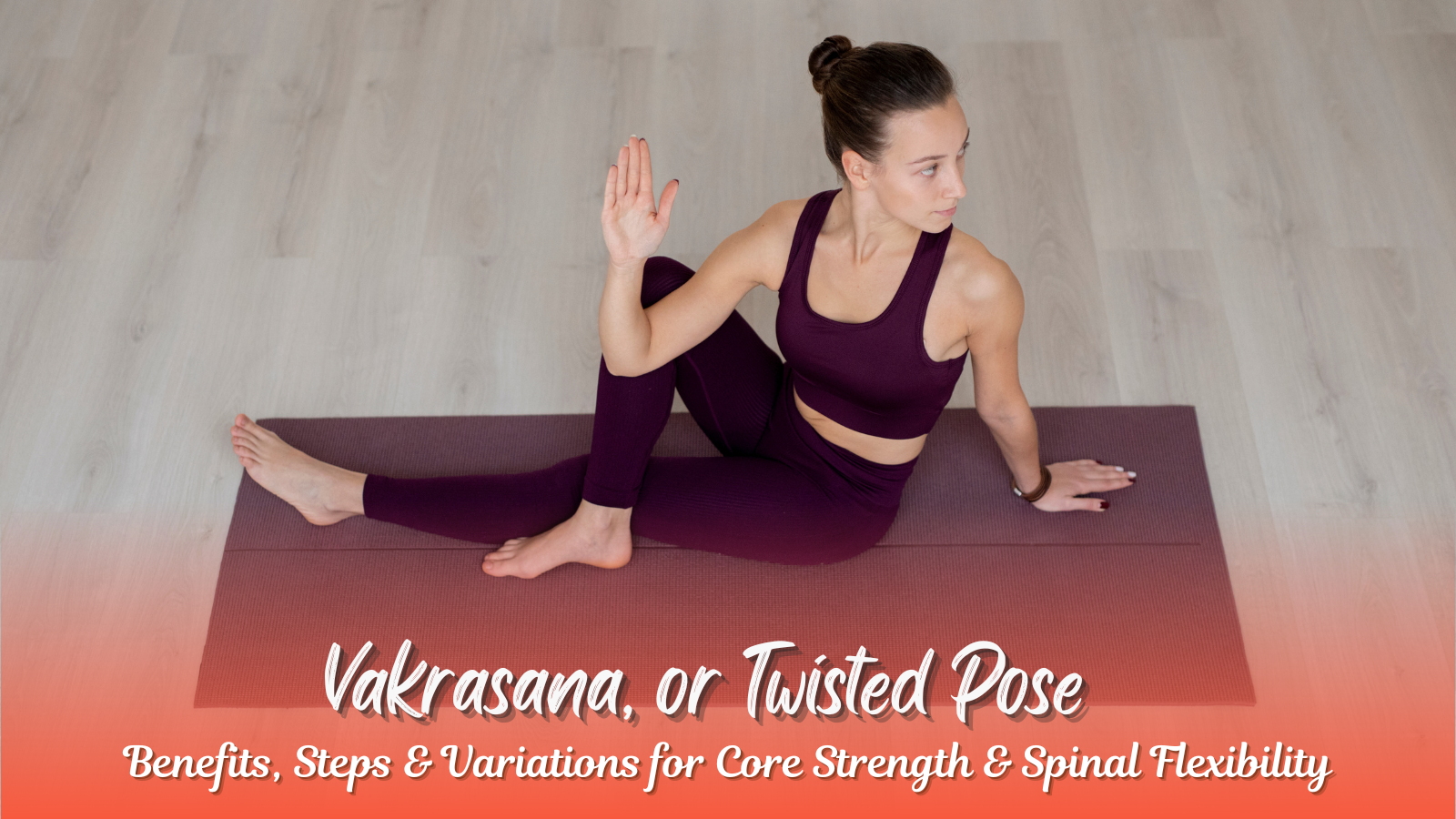Vakrasana Introduction
Vakrasana, or Twisted Pose, is a seated yoga posture that twists the spine and engages muscles in the core. It is one of the foundational postures that have been proven to be very beneficial for spinal mobility, flexibility, and strength in the core. It improves digestion, relieves tension, and enhances balance. It is ideal for beginners and advanced practitioners.
We will practice the steps of Vakrasana, explore the Vakrasana benefits, Vakrasana steps, Vakrasana precautions, Vakrasana yoga sequences and Vakrasana variations. We will also pay attention to many variations of the Vakrasana pose like Kati Vakrasana, Meru Vakrasana, and Uttana Vakrasana, twisting yoga pose, spinal flexibility pose, and seated twist pose and describe how this asana impacts the whole body along with the mind.
What is Vakrasana?
Vakrasana is a word in the Sanskrit vocabulary meaning “twisted pose.” “Vakra” means twisted or curved, and “Asana” means posture. The twist happens in the spine while keeping the legs in seated position. Vakrasana is one of those dynamic asanas, which demands flexibility in the spine, hips, and shoulders. It is often practiced in a series of yogas to increase body flexibility and straighten out the postures.
This asana can be practiced in various versions, namely Kati Vakrasana, Meru Vakrasana, and Uttana Vakrasana, each having its specific challenge and advantage.
Vakrasana Benefits: Why You Should Include It in Your Yoga Practice
Health Benefits of Vakrasana:
Vakrasana offers many physical and mental benefits. It is one of the best stretchings for flexibility that strengthens the core and develops the health of the spine. The following are the major vakrasana procedure benefits and contraindications:
1. Improves Spinal Flexibility:
The greatest advantage of Vakrasana is that it makes the spine more flexible. The twisting action in the pose frees the tension of the back and facilitates the movement of the vertebrae. Gradually, the stiffness in the spine is relieved, and posture improves through regular practice of Vakrasana.
2. Strengthens the Core Muscles:
Vakrasana works on the abdominal and oblique muscles. It activates these muscles by giving them tone and strength and thus assists with posture, all activities of daily life, and provides for an easier balance or stability in the other asanas.
3. Enhances Digestion:
The gentle pressure on the abdomen while twisting in Vakrasana helps massage the digestive organs, and hence, increases the efficiency of the digestive system. It may also help prevent bloating and constipation due to the stimulation of the digestive process and easy bowel movements.
4. Reduces Stress and Tension:
For instance, the twisting postures, such as Vakrasana, are an excellent method of unstressing and de-tensioning the body. The proper turn of the spine really stimulates the nerve system, which in turn relieves the tension of the mind. That is why it has acted effectively in keeping away anxiety and mental fatigue.
5. Increases Blood Circulation:
This distorted movement in kativakrasana enables enhanced blood circulation inside the spinal cord and internal organs. Blood circulation is enhanced when cells become full of oxygen and nutrients and remove the waste products. It can thus boost energy levels and vigor.
6. Improved Posture
The correct posture is substantially improved by practicing Vakrasana regularly. In fact, even the twisting movement itself helps align the spine and strengthen the posterior muscles, while it also is an antidote to long periods of sitting hours.
7. Relieves Lower Back Pain:
This could be a remedial asana for people having pain in their lower back since the twisting, in a slow and gentle motion, loosens up the areas in the back that tend to become stiff by tension and pressure.
How to do Vakrasana: Step-by-Step Guide
Vakrasana Steps
The Vakrasana is a relatively simple posture to perform, but, as with any yoga pose, patience and practice are essential. The steps for mastering the full benefit of the vakrasana images are given below:
Step-by-Step Procedure of Vakrasana:
Step- 1 Sit on the floor by extending your legs straight before you. Ensure your spine remains straight and activate your core muscles. Place your palms flat on the ground next to your hips to support you.
Step- 2 Fold Your Right Leg: Fold your right knee and bring it close to the chest, right foot on the floor, flat. The right knee will now point upwards while the foot remains near the left thigh.
Step- 3 Twist Your Upper Body: Inhale, and extend your spine. As you exhale, twist your torso to the right, taking your left elbow across to the outer side of your right knee. Keep your spine straight; avoid collapsing into the twist.
Step- 4 Engage Your Core: In any twist, you want to engage your core to allow for the most depth into the twist that stabilizes you. You can place your right hand on the floor behind you or on your right knee to add stabilization.
Step- 5 Hold the Twist: Hold the twist for 20-30 seconds, breathing deeply and steadily. Your shoulders should remain relaxed, and your chest open. Twist from the spine, not from the shoulders.
Step- 6 Release and Repeat on the Other Side: Slowly release the twist and return to the starting position. Repeat the same steps on the left side. Keep your spine straight throughout the movement.
Precautions and Contraindications of Vakrasana:
Although Vakrasana is safe and helpful for most, here are a few precautions and vakrasana contraindications to consider:
•Avoid if You Have a Spine Injury: If you have any injuries or conditions related to the spine, such as herniated discs or sciatica, it is best to avoid twisting poses like Vakrasana unless you are assisted by a qualified yoga instructor.
• Pregnancy: Pregnant women should take permission from their doctor before practicing Vakrasana or any twisting poses since it may not be safe in pregnancy, especially towards the later periods.
• Severe Lower Back Pain: People with severe lower back pain should avoid deep twists in Vakrasana until such time as their pain is under control. A gentle variation of the twist can be maintained by keeping the twist shallow.
•Knee or Hip Injuries: It is primarily good to be cautious when practicing this pose in case you have knee or hip injuries. Make all your movements gentle and avoid any deep twisting motions that may strain those areas.
Vakrasana Steps: Mastering the Twisting Yoga Pose
Vakrasana Variations:
Kati Vakrasana (Hip Twist Pose):
Kati Vakrasana – It is a variation of standing vakrasana in which the body twist is taken such that one hand reaches back behind to grab for the opposite knee. It would be much more of a spine twist along with opening up of the hip and lower back so that more flexibility is developed.
Meru Vakrasana (Twisted Half Moon Pose):
Meru Vakrasana is another advanced variation of Vakrasana. In this pose, one raises one leg while twisting the upper body with that leg forward to reach out to the toes of the leg which is lifted up. This posture gives more extension in the spine and is very engaging.
Uttana Vakrasana or Extended Twisted Pose
You are reaching forward to stretch the torso more and lengthen the spine in Uttana Vakrasana. It will stretch your lower back, hips, and shoulders.
Supta Vakrasana is also called Reclined Twisted Pose.
Supta Vakrasana is a lying variation of the posture. In it, one offers forward bends to the lower part of the body with grounded shoulders; the twist in the lower part would be very smooth and gentle for the spine and lower back.
Ardha Vakrasana (Half Twisted Pose):
In Ardha Vakrasana, only part of the body is twisted. That could either be an upper or a lower part of the body. It is hence relatively the milder form of the classic Vakrasana.
Vakrasana Yoga Teacher Training
It is in such a beautiful and serene environment that you can go for further knowledge of Vakrasana, as well as any number of other yoga poses, by studying a 200-hour yoga teacher training course in Rishikesh. The good thing is that most yoga teacher training schools in Rishikesh offer full-scale training for the theory and practice of Vakrasana and other asanas, including modifications and variations.
Some of the very best yoga schools in Rishikesh specialize in particular subjects, like the Sound Healing Yoga Teacher Training that combines physical asana practice and sound healing in a holistic, deepened sense of understanding through yoga as lifestyle and practice way beyond the mat.
Vakrasana is a great asana that creates flexibility while strengthening the core and overall benefit to the being. Some of the other benefits associated with this asana are improved mobility in the spine, improved digestion, and less stressfulness. Regular practice will build up a sound foundation for coming difficult practices. Simultaneously, you will also get the maximum benefit of increased flexibility and balancing consciousness.
With proper learning of the steps of Vakrasana, you can easily include it in your practice and experience all the benefits of this pose. It could be Kati Vakrasana or Uttana Vakrasana, or any other variation of this asana. All you have to do is listen to your body and modify the pose as you feel is required. If you want to enhance your skills further, explore a 200-hour yoga teacher training in Rishikesh.
Frequently Asked Questions (FAQS)
What is Vakrasana in Sanskrit?
Vakrasana (Twisted Pose) comes from the Sanskrit words “Vakra” (twist) and “Asana” (posture). This seated yoga pose involves twisting the spine, creating a deep stretch for the back, improving spinal flexibility, strengthening the core, and aiding digestion. It is a foundational pose in many yoga sequences and offers numerous benefits for both beginners and advanced practitioners.
Is Vajrasana Good for Diabetes?
Yes, Vajrasana (Diamond Pose) can benefit people with diabetes by improving digestion and metabolism. This posture stimulates the digestive organs, enhances blood circulation, and helps regulate blood sugar levels to some extent. However, it should be practiced regularly and combined with a balanced lifestyle for maximum benefits.
What are the Benefits of Vajrasana for Diabetes?
✅ Improves Digestion – Sitting in Vajrasana after meals helps improve digestion, indirectly supporting better blood sugar control.
✅ Stimulates the Pancreas – The posture gently massages the pancreas, encouraging insulin production, which is crucial for diabetes management.
✅ Reduces Stress – Since stress can negatively impact blood sugar levels, Vajrasana helps calm the nervous system and lower stress.
Note: If you have diabetes or any health concerns, consult a healthcare professional or a certified yoga instructor before practicing Vajrasana regularly.
Who Should Avoid Vajrasana?
While Vajrasana is generally safe, certain individuals should avoid or modify the pose:
🚫 People with Knee Injuries – If you have knee pain, arthritis, or ligament damage, avoid prolonged sitting in Vajrasana as it puts pressure on the knee joints.
🚫 Those with Severe Back Pain – Individuals with lower back issues may find it uncomfortable. If practiced, ensure your spine remains straight and avoid prolonged sitting.
🚫 Pregnant Women – Sitting in Vajrasana for too long can add pressure to the pelvic region. Pregnant women should only practice it under expert supervision.
🚫 People with Severe Digestive Issues – If you have conditions like hernia or chronic gastric problems, Vajrasana may increase intra-abdominal pressure and should be avoided.
Tip: If you experience discomfort, practice Vajrasana for shorter durations or use props like cushions to reduce strain.
Can Vajrasana Be Done on a Bed?
Yes, Vajrasana can be done on a bed, but it may not be as effective as practicing on a solid surface.
✅ Advantages of Doing Vajrasana on a Bed:
- Comfortable for Seniors & Injured Individuals – Practicing on a softer surface can be easier on the knees and back.
- Stress Relief – Sitting in Vajrasana on a bed before sleep can help relax the mind and body.
❌ Disadvantages of Doing Vajrasana on a Bed:
- Lack of Stability – A soft surface reduces stability, making it harder to maintain proper posture.
- Reduced Effectiveness – Vajrasana is more beneficial on the floor as it provides better grounding and alignment.
Recommendation: If practicing on a bed, use a firm mattress and maintain correct posture to avoid unnecessary strain.
If you prefer to do the Vajrasana on your bed, still keeping your body posture straight and using some cushions or a blanket for extra support.
Conclusion
If you really want to dive deeply into the transformative power of yoga, consider attending a 200 Hour Yoga Teacher Training at an established Yoga Gurukul in Rishikesh. The program will give you the best yoga and meditation training but teaches you to live a more centered, mindful life. You shall discover the depth of your practice in a truthful and nurturing environment, be given the confidence and tools to succeed in all aspects of your life.


